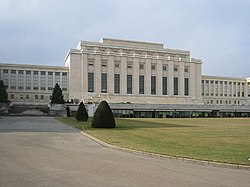League of Nations
League of Nations Société des Nations (French) | |||||||
|---|---|---|---|---|---|---|---|
| 1920–1946 | |||||||
|
Semi-official flag (1939–41) | |||||||
 Headquarters of League of Nations at Geneva, Switzerland | |||||||
| Status | Intergovernmental organisation | ||||||
| Capital | Geneva, Switzerland[a] | ||||||
| Administrative center | Geneva, Switzerland | ||||||
| Common languages | French and English | ||||||
| Secretary‑General | |||||||
• 1920–33 | Sir Eric Drummond | ||||||
• 1933–40 | Joseph Avenol | ||||||
• 1940–46 | Seán Lester | ||||||
| Deputy Secretary-General | |||||||
• 1919–23 | Jean Monnet | ||||||
• 1923–33 | Joseph Avenol | ||||||
• 1937–40 | Seán Lester | ||||||
| Historical era | Interwar period | ||||||
| 10 January 1920 | |||||||
• First meeting | 16 January 1920 | ||||||
| 20 April 1946 | |||||||
| |||||||
| |||||||
The League of Nations (French: Société des Nations) was the predecessor to the United Nations. The League was founded in 1920, after World War I, but failed to maintain peace and prevent World War II. The League had a Council of the great powers and an Assembly of all of its member countries.
The League of Nations was thought up by US President Woodrow Wilson during World War I. It was to be a group of nations that worked together to keep peace. One of the reasons for its downfall was that, after a vote, the US Senate refused to join.
The League did not have the power to enforce any of its rules. That later proved to be a fatal flaw in the League's structure.
Another flaw in the League was that it was not representative enough. It never had more than 65 members, and the interests of the great powers often outweighed those of weaker members.
The League also had no troops of its own, and the decisions that it made were often slow. For example, when the Empire of Japan invaded Manchuria (North-eastern China) in 1931, the League took a whole year to decide to tell Japan to leave. Instead, Japan left the League. When Italy invaded Abyssinia in 1935, the League condemned it more quickly. Italy simply left the League and finished its conquest. After these disasters, the League was thought to be weak and powerless and stopped operations in 1939.
The League did not fail completely since it had prevented a few conflicts in Europe in the 1920s and worked hard to relieve various public health and social problems around the world.
In 1946, the inactive League of Nations formally ended and was replaced by the United Nations, which still does many of the same things that the League of Nations did.
United States
[change | change source]US President Woodrow Wilson arranged a plan for a "government of governments", or an international peacekeeping force. The idea was to settle problems between nations peacefully. Wilson tried to persuade the international community that the League would discourage aggression and tackle the underlying problems that often lead to war such as poverty. Wilson was, however, unable to convince the American public to support the League. The United States did not want to be part of Wilson’s approach for three reasons:
First, the United States had many German Americans who hated the Treaty of Versailles for blaming Germany for the war and making it pay heavy war reparations. To join the League of Nations, a country had to agree and accept the Treaty of Versailles. The German American people did not accept the treaty.
Second, Americans did not want to risk more Americans dying in another European war, like in World War I. They felt that it would result in pointless actions such as sending soldiers all around the globe to sort out small disputes. That attitude was called isolationism. Most Americans felt it would be best to avoid British and other European affairs completely.
Third, the granting of women's voting rights in the United States brought a huge new voting block, which overwhelmingly desired to turn inward. Women were even more likely than men to oppose war and to be isolationist.
However, the United States joined most of the specialized agencies of the League, such as the International Postal Union.
Members
[change | change source]1920
[change | change source]These countries joined League of Nations in 1920:
 Argentina (left in 1921 and joined again in 1933)
Argentina (left in 1921 and joined again in 1933) Australia
Australia Belgium
Belgium Bolivia
Bolivia Brazil (left the organization in 1926)
Brazil (left the organization in 1926) British Empire
British Empire
United Kingdom of Great Britain and Ireland, Dominion of Canada, Commonwealth of Australia, Federation of New Zealand, Union of South Africa
 Canada
Canada Chile (left in 1938)
Chile (left in 1938) China
China Colombia
Colombia Cuba
Cuba Czechoslovakia (left in 1939)
Czechoslovakia (left in 1939) Denmark (left in 1940)
Denmark (left in 1940) El Salvador (left in 1937)
El Salvador (left in 1937) France
France Greece
Greece Guatemala (left in 1936)
Guatemala (left in 1936) Haiti (left in 1942)
Haiti (left in 1942) Honduras (left in 1936)
Honduras (left in 1936) India
India Kingdom of Italy
Kingdom of Italy Empire of Japan
Empire of Japan Liberia
Liberia Netherlands
Netherlands Nicaragua (left in 1936)
Nicaragua (left in 1936) Norway
Norway Panama
Panama Paraguay (left in 1935)
Paraguay (left in 1935) Iran
Iran Peru (left in 1939)
Peru (left in 1939) Poland
Poland Portugal
Portugal Romania (left in 1940)
Romania (left in 1940) Siam
Siam Spain (left in 1939)
Spain (left in 1939) Sweden
Sweden Switzerland
Switzerland Uruguay
Uruguay Venezuela
Venezuela
Other websites
[change | change source]![]() Media related to League of Nations at Wikimedia Commons
Media related to League of Nations at Wikimedia Commons

